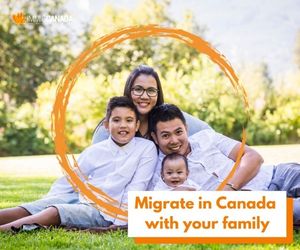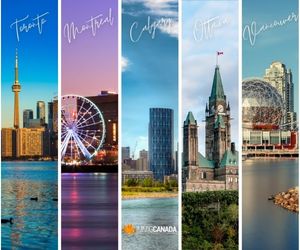Immigration Announcement
Understanding the Array of Visa Options in Canada

Canada, a land of diverse opportunities and experiences, extends a range of visa options, catering to both temporary and permanent residency aspirations. Navigating through the various visa categories is crucial for individuals aiming to align their immigration journey with their specific circumstances.
1. The Essence of Canadian Visas
A Canadian visa serves as an official document sanctioned by the Canadian government, granting foreign nationals entry and residence in the country for a designated purpose and duration. Distinct from work or study permits, this entry document is typically affixed inside a passport. Understanding the diverse visa categories is paramount for prospective immigrants, guiding them through the intricacies of exploring Canada’s cultural richness, educational institutions, and professional opportunities.
Maximize Your IELTS Score:
Start your English journey: Learn English with British Council teachers — Up to 30% off
English Online Self-Study course: Learn English at your own pace with bite-sized exercises — Up to 30% off
Prepare for IELTS with the experts: Get the score you need with the co-creator of the IELTS test- Up to 30% off
2. Canadian Visa Category Codes
Canadian visas are denoted by category codes, representing the type and purpose of the visa. These codes, a combination of letters and numbers, are crucial identifiers printed on visa labels or stamps in passports. Here is an overview of some key category codes along with their corresponding visa descriptions:
| B-1: Business Visitor | C-1: Courtesy |
| D-1: Diplomat | F-1: Facilitation Visa |
| IM-1: Immigrant (single-entry visa for PR) | 0-1: Official |
| P A-1: Permit Holder | PAX-1: National Interest TRP |
| PC-1: Permit Holder with Valid TRP | PG-1: Parents or Grandparents Super Visa |
| R-1: Passed-Residency Obligation | RA-1: Presence at Appeal |
| RC-1: Passed H&C – PR Travel Document | RX-1: Attending a PR hearing while you were present in Canada in the past 365 days. |
| S-1: A student with a Study Permit | SW-1: An international student with Study & Work Permit |
| SX-1: A student exempt from the requirement to obtain a Study Permit | V-1: Visitor |
| VH-1: Visitor in Transit for not more than 48 hours | W-1: A worker with Work Permit |
| WX-1: A worker exempts from the requirement to obtain a Work Permit | – |
3. Temporary Canadian Visas
Work Visa
A temporary work visa permits individuals to live and work in Canada for the validity period specified in the work permit. There are various types of work permits, including:
- Open Work Permit: Permits to work for any employer across Canada without requiring a Labour Market Impact Assessment (LMIA). Primarily available to adults accompanying family members on a study permit.
- Employer-Specific Work Permit: Linked to a specific job offer, usually requiring an LMIA to prove unsuccessful attempts to find a Canadian citizen or permanent resident for the role.
- Post-Graduation Work Permit (PGWP): An open work permit for international graduates, lasting up to three years based on the length of the completed program.
- International Experience Canada (IEC): Bilateral agreements allowing citizens from certain countries to travel and work in Canada under categories such as working holiday, young professional, and international co-op internship.
Study Visa
Individuals planning to study in Canada for a program exceeding six months must obtain a study permit. Key considerations include acceptance into a program at a Designated Learning Institution (DLI), demonstrating sufficient funds, and the intention to leave Canada after permit expiration. Studying in Canada can also serve as a pathway to permanent residence through programs like the Post-Graduate Work Permit (PGWP).
Visitor Visa
For those intending to visit Canada, several visa options are available:
- Single Entry Visitor Visa: Allows one-time entry for a fixed period, requiring reapplication for subsequent visits.
- Multiple Entry Visitor Visa: Permits multiple entries and exits for up to 6 months each time, valid for up to 10 years.
- Super Visa: An extended stay temporary resident multiple-entry visa for parents or grandparents, lasting up to 10 years with an initial visit duration of up to 24 months.
- Electronic Travel Authorization (ETA): Required for air travel to Canada for citizens of visa-exempt countries, excluding US citizens.
4. Permanent Residence in Canada
Individuals aspiring for permanent residency in Canada can explore various immigration routes, such as:
Express Entry
Express Entry is a swift pathway to permanent residence, managing programs like Federal Skilled Workers, Federal Skilled Trades, and Canadian Experience Class. Eligible candidates submit profiles to the Express Entry pool, where rankings determine Invitations to Apply (ITA) for permanent residence. Processing times can be as short as six months.
- Federal Skilled Worker Program: Requires at least one year of skilled work experience, minimum language proficiency, and a score of at least 67 out of 100 points on the selection grid.
- Federal Skilled Trades Program: Demands two years of skilled trade experience, language proficiency, and a Canadian certificate of qualification or a job offer in the skilled trade.
- Canadian Experience Class: Open to candidates with at least one year of work experience in Canada on a valid work permit.
Provincial Nominee Program (PNP)
Operated by provinces (except Quebec), the Provincial Nominee Program (PNP) provides immigration streams with varying criteria. While some programs require a connection to the province, others target specific labor market needs.
Quebec Immigration
Quebec possesses autonomy in immigration policies, requiring applicants to obtain provincial approval before federal consideration. Programs include Quebec Experience Class and Quebec Skilled Worker, each with specific eligibility Sponsorship
As a Canadian citizen, registered Indian, or permanent resident, sponsoring relatives (parents, spouse, children) for permanent residence is possible. Sponsors must meet specific criteria, enabling their relatives to live, study, and work in Canada. Understanding the multitude of Canadian visa options is crucial for making informed decisions about one’s immigration journey.
Whether pursuing temporary opportunities or aiming for permanent residency, the diverse pathways reflect Canada’s commitment to welcoming individuals with various aspirations. Navigating through the nuances of each visa category ensures a seamless and well-prepared application process, aligning with the unique circumstances and goals of each applicant.






















